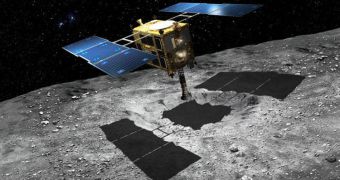The NEC Corporation, in Tokyo, has recently announced that work to create a successor for the Hayabusa sample-return spacecraft has begun. The company is developing Hayabusa-2 for the Japan Aerospace Exploration Agency (JAXA), targeting a 2014 launch date.
The first Hayabusa (Japanese for peregrine falcon) launched on May 9, 2003, and managed to return to Earth on June 13, 2010. Though it did manage to reach the asteroid 25143 Itokawa – its main target – it did not manage to return more than a few microscopic grains of material from the space rock.
In addition, the spacecraft was plagued by a very large number of technical difficulties, malfunctions and failure, to such an extent that no one was expecting it to return successfully to Earth. It was only the ingenuity of JAXA engineers and mission controllers that made this mission a partial success.
Sample-return spacecraft, as their name implies, are usually set on a course to an asteroid or comet. Once in the vicinity of their targets, they either send a lander to the surface, or shoot cables to pull themselves closer. Grains of material are then collected in specialized chambers.
Once the procedure is complete, the spacecraft separate from the target objects, and head back home. Usually, they parachute the sample chambers from orbit. This method of collecting samples is very difficult to complete, as evidenced by the fact that less than a handful of such missions were ever successful.
JAXA is keen on demonstrating that it learned from the lessons taught by Hayabusa. The second iteration of the spacecraft will carry two landers and an impactor, in order to maximize its chances of actually collecting relevant amounts of samples.
According to the announcement made by NEC, Hayabusa-2 should launch by the end of 2014, and return to Earth sometime in 2020. Its current target is the carbonaceous-type asteroid 1999 JU3.
The probe will be powered by an ion engine, which will enable it to move very fast and with great precision. If launched in 2014, it would meet up with 1999 JU3 by mid-2018, Space reports.
JAXA estimates the total cost of the mission to be around $400 million. Hayabusa-2 will spend about one year orbiting its target asteroid, 4 times longer than what the original Hayabusa had at its disposal.
The goal of such studies is to gain a better understanding of how the Sun, the planets and the entire solar system formed. Astronomers suspect that it looked very different about 4 and a half billion years ago.

 14 DAY TRIAL //
14 DAY TRIAL //